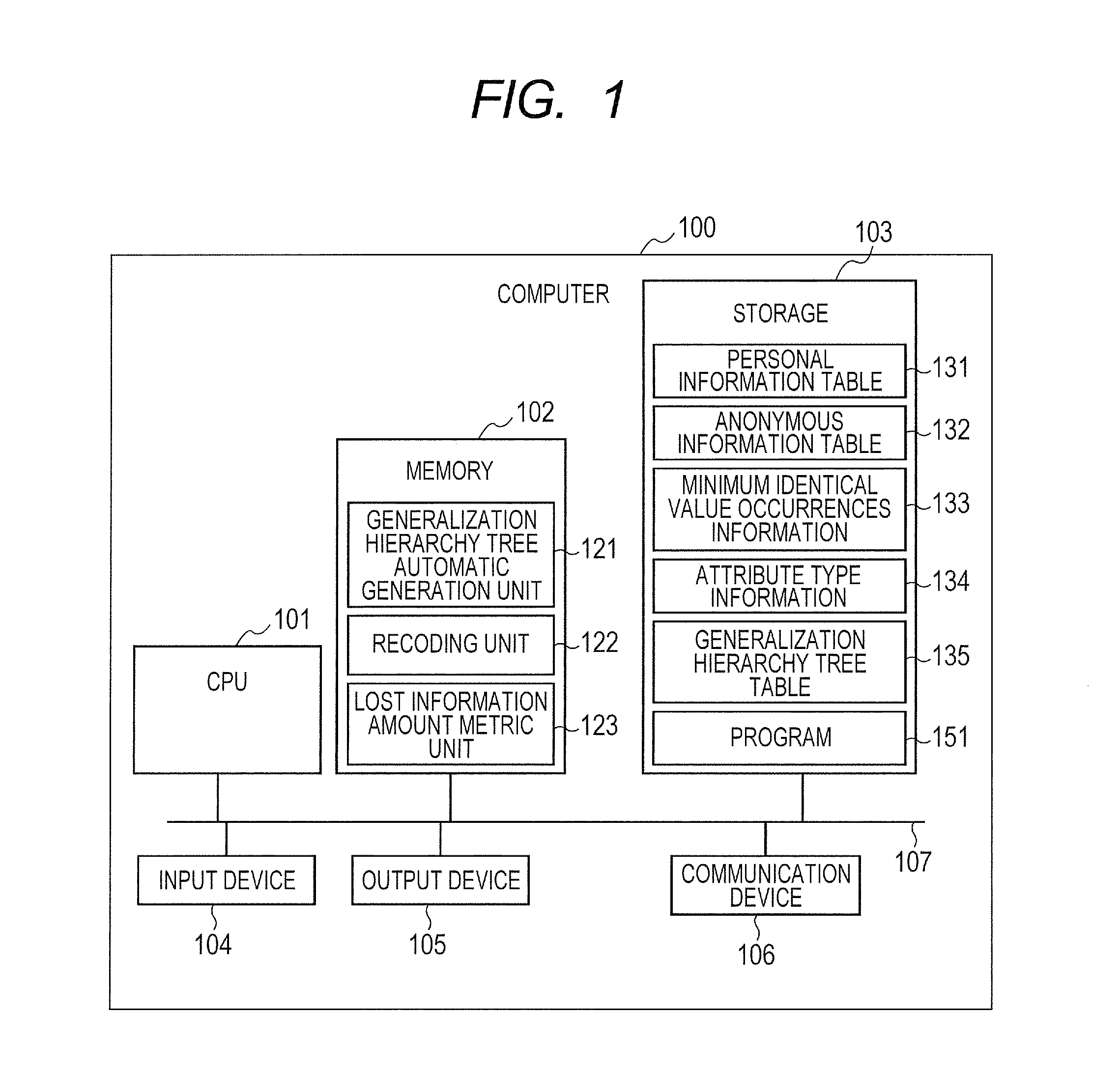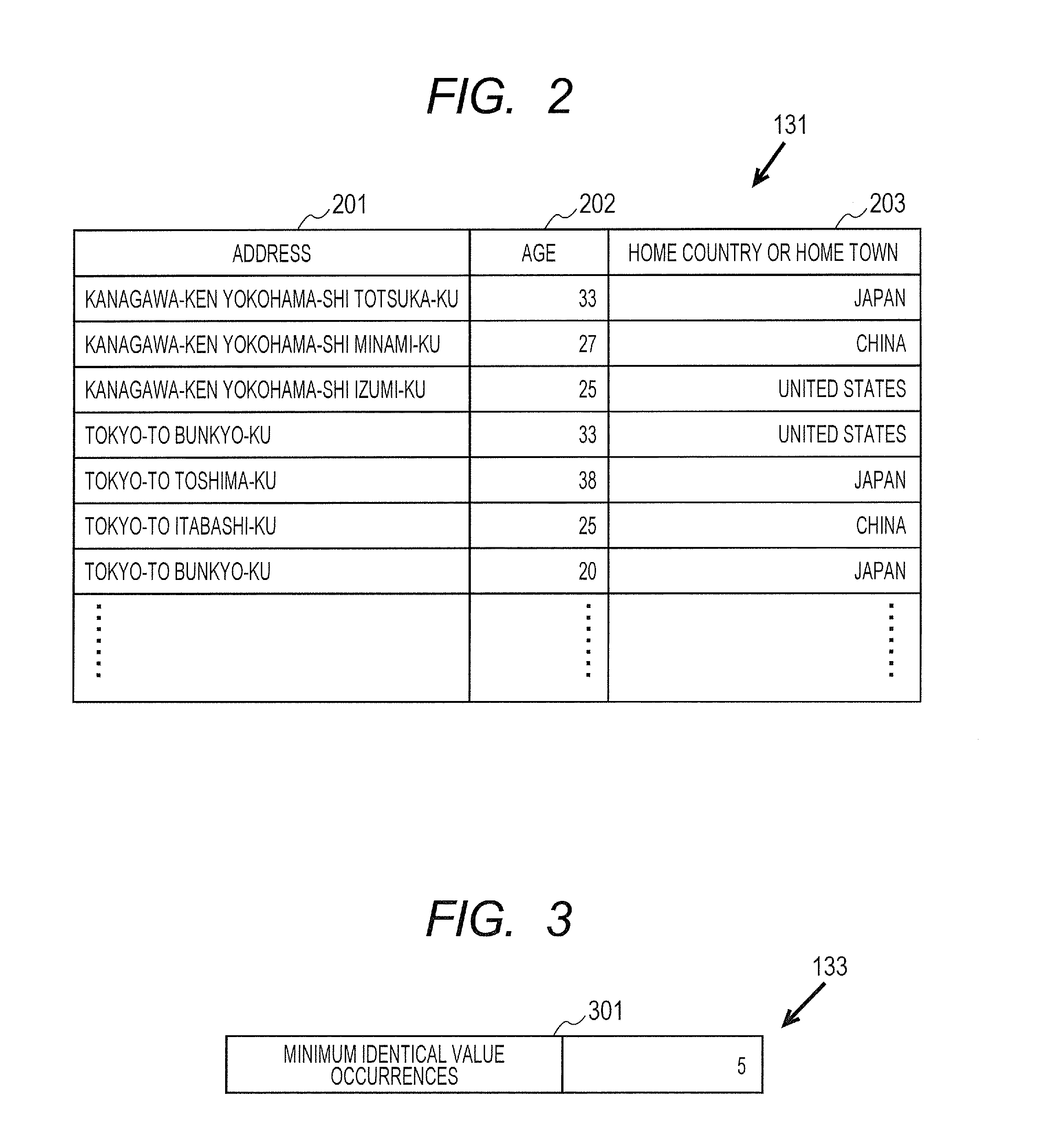Identity information de-identification device
- Summary
- Abstract
- Description
- Claims
- Application Information
AI Technical Summary
Benefits of technology
Problems solved by technology
Method used
Image
Examples
first embodiment
[0047]A configuration example of a device that implements a technology of a first embodiment will be described with reference to FIG. 1.
[0048]FIG. 1 is an example that configures devices on a computer. In FIG. 1, the computer 100 is an arbitrary information processing device such as a PC (personal computer), a server, or a workstation. The computer 100 includes a CPU (central processing unit) 101, a memory 102, a storage 103, an input device 104, an output device 105, and a communication device 106, which are connected to each other via an Internal communication line 107 such as a bus.
[0049]The storage 103 is, for example, a storage media such as a CD-R (compact disc recordable), a DVD-RAM (digital versatile disk random access memory), or a silicon disk, a driving device of the storage media, or an HDD (hard disk drive). The storage 103 stores a personal information table 131, an anonymous Information table 132, a minimum, identical value occurrence information 133, an attribute typ...
second embodiment
[0132]Next, a second embodiment will be described. The second embodiment improves the usability of data. Hereinafter, when the second embodiment is described, configurations which overlap the first embodiment are denoted by the same reference numerals and the description thereof will be omitted. Further, most operations of the second embodiment are the same as in the first embodiment. The same operations are denoted by the same reference numerals, and the description thereof will be omitted.
[0133]First, referring to FIG. 13, a configuration example of a computer 100 according to the second embodiment will be described.
[0134]In FIG. 13, a storage 103 of the computer 100 has a program 1331 instead of the program 151. The program 1331 is loaded on the memory and the CPU 101 implements a pseudo-personal information generation unit 1321 in addition to the units 121, 122, and 123 of the first embodiment. Further, as a storage destination of the processing result of the program 1331, a gen...
third embodiment
[0146]Next, a third embodiment will be described.
[0147]The third embodiment uses a classification of the attribute values which is desired by a user to improve the availability of data. In various fields such as international classification of diseases, a library classification, or a patent classification, a predetermined classification is present. Further, as for an age, a frequently used classification such as 10's or 20's is present. The third embodiment automatically generates a generalization hierarchy tree while considering a user-desired classification by defining only a hierarchy structure which is desired by the user as a generalization hierarchy tree in advance. For example, the age classification is defined as “20 to 24 years old” and “25 to 29 years old” in advance so as to prevent the data from being receded such that the classification departs from the user desired classification such as “24 to 27 years old”.
[0148]Further, when the generalization hierarchy tree is conf...
PUM
 Login to View More
Login to View More Abstract
Description
Claims
Application Information
 Login to View More
Login to View More - R&D
- Intellectual Property
- Life Sciences
- Materials
- Tech Scout
- Unparalleled Data Quality
- Higher Quality Content
- 60% Fewer Hallucinations
Browse by: Latest US Patents, China's latest patents, Technical Efficacy Thesaurus, Application Domain, Technology Topic, Popular Technical Reports.
© 2025 PatSnap. All rights reserved.Legal|Privacy policy|Modern Slavery Act Transparency Statement|Sitemap|About US| Contact US: help@patsnap.com



